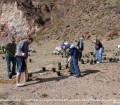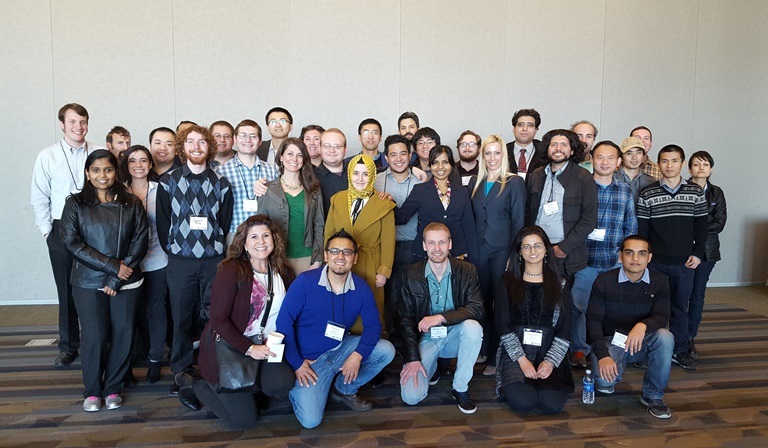By Jane Palmer
March 2016
Twenty-one students presented posters at the NEXUS annual meeting covering every aspect of the project’s mission. Although the presentations were unified in their excellence, we highlight just three posters that relate to NEXUS’s core objectives: Supporting the water needs of solar energy development, increasing the efficiency of solar energy supplies and accelerating NEXUS research with new advanced data services.
Putting Numbers on the Water Requirements of Solar Energy
The sunny southwestern U.S. possesses tremendous potential for capitalizing on solar energy, but for the lack of water. To understand whether this region could support sustainable solar energy development, Saria Bukhary, a graduate student at the University of Nevada, Las Vegas, has put numbers on the water requirements of solar photovoltaics (PV) and concentrated solar power (CSP) technologies in distinct locales. She then aligned this data with the available water resources and the estimated reduction in carbon dioxide at these sites, using a system dynamics model. When Bukhary performed this analysis on the state of Nevada to meet the goals of renewable portfolio standard (RPS) during the period 2010-2030, she found that the unappropriated groundwater resource has the potential to meet the water demands of certain configurations of PV and CSP solar installations during that time period. “The study is very important because without water we won’t have any solar technology,” says Bukhary. “So we need to know what water is needed and whether it is there.”
Estimating Aerosols Role in Degrading Solar Panels
Minute particles suspended in the atmosphere—aerosols— turn out to have outsized impacts on the efficiency of solar panels, with dire financial consequences. The first step to tackling this challenge lies in understanding the effects of these aerosols, but this is difficult because the optical effect of these particles are not well understood. Patricio Piedra, a graduate student at the Desert Research Institute, is attempting to simulate the action of this ‘particle-substrate’ system using discrete dipole approximation (DDA), with significant success. In the future, DDA could have the potential to predict solar cell performance during particle deposition. In doing so it could help solar power forecasting and inform the creation of optimal cell cleaning schedules and procedures. “Eventually I hope to be able to develop a program that will predict the rate of degradation of solar panels,” says Peidra. “That is important because in some locations we can’t do experiments so having a model is important.”
An App for Gathering Climate Data
When it comes to gathering varied climate data on a minute-by-minute basis, day after day, a log book doesn’t quite cut it. To help ease the pain of documenting every minutiae of the atmosphere, Hannah Munoz, Samantha Grant, Matthew Salivar, Vinh Le, Royal Stewart, and Eric Fritzinger, all undergraduate students at the University of Nevada, Reno (UNR) have developed an App for the Android mobile platform for NEXUS technicians in the field. These technicians, working at thirteen remote sites across Nevada will be able to log information about these sites during their trips and then stream this data to the Nevada Research Data Center (NRDC), where it will be stored. “Our objective is to provide the field technicians with an effective method of creating documentation for their work and also provide them with a positive and satisfying experience when servicing these stations,” Munoz says.
Click here to find out more about the graduate student presentations.







